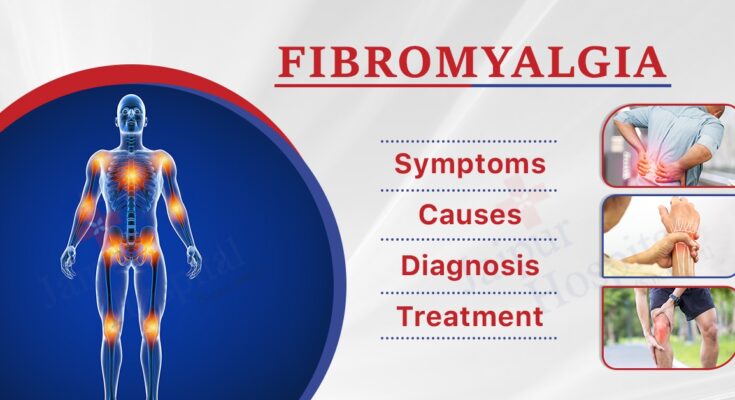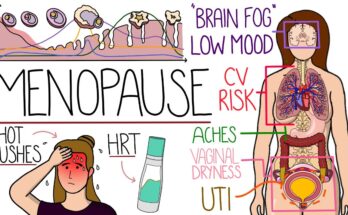Fibromyalgia Symptoms: Fibromyalgia is a chronic condition characterized by widespread pain and a host of other symptoms. It affects millions of people worldwide, imposing a significant burden on individuals and healthcare systems alike.
Understanding its symptoms and causes is the first step towards managing this complex condition.
What is Fibromyalgia?
Fibromyalgia is a chronic condition characterized by widespread musculoskeletal pain accompanied by fatigue, sleep, memory, and mood issues. Researchers believe fibromyalgia amplifies painful sensations by affecting the way the brain and spinal cord process painful and nonpainful signals. Symptoms often begin after a physical trauma, surgery, infection, or significant psychological stress. In other cases, symptoms gradually accumulate over time with no single triggering event.
Women are more likely to develop fibromyalgia than men. Many people who have fibromyalgia also have tension headaches, temporomandibular joint (TMJ) disorders, irritable bowel syndrome, anxiety, and depression. While there is no cure for fibromyalgia, a variety of medications can help control symptoms. Exercise, relaxation, and stress-reduction measures also may help.
Statistics on Prevalence
Understanding the prevalence of fibromyalgia helps in grasping its impact on society. According to the Centers for Disease Control and Prevention (CDC), fibromyalgia affects approximately 4 million adults in the United States, or about 2% of the adult population. The condition is most commonly diagnosed during middle age and is more prevalent in women; in fact, it is estimated that 75-90% of people with fibromyalgia are female.
Globally, the prevalence of fibromyalgia varies, with estimates suggesting that 2-4% of the world’s population is affected. The variation in prevalence rates may be attributed to differences in diagnostic criteria, awareness, and healthcare access across different countries.
The data underscores the importance of understanding fibromyalgia as a significant public health issue. It highlights the need for research, improved diagnostic criteria, and effective management strategies to better support those living with this condition.
Symptoms of Fibromyalgia
This detailed guide aims to shed light on the common symptoms associated with fibromyalgia, elucidating how their intensity and frequency may vary from person to person. Furthermore, it underscores the crucial role of tracking these symptoms in the journey towards an accurate diagnosis.
Detailed List of Common Fibromyalgia Symptoms
Fibromyalgia is characterized by a wide range of symptoms, making it a condition that can be challenging to diagnose. The most prevalent symptom is a persistent pain throughout the body, described often as a deep, aching, throbbing, or stabbing pain. However, the symptoms extend beyond pain, encompassing:
- Widespread Pain: The hallmark of fibromyalgia, this pain is often described as a constant dull ache lasting for months.
- Fatigue: Despite sleeping for long periods, individuals may wake up tired and unrefreshed. Sleep is frequently disrupted by pain, and many individuals with fibromyalgia have other sleep disorders, such as restless legs syndrome and sleep apnea.
- Cognitive Difficulties: A symptom commonly referred to as “fibro fog” impairs the ability to focus, pay attention, and concentrate on mental tasks.
- Emotional Symptoms: Anxiety and depression often accompany fibromyalgia, impacting mental health.
- Other Symptoms: Headaches, irritable bowel syndrome, numbness or tingling in hands and feet, and sensitivity to temperature, loud noises, or bright lights are also reported.
Variability in Symptoms’ Intensity and Frequency
The symptoms of fibromyalgia can fluctuate in intensity and frequency, presenting a significant challenge for those affected. Factors such as stress, weather changes, physical activity, and even the time of day can influence these symptoms. Some individuals may experience symptoms that are relatively stable and manageable, while others face periods where symptoms significantly worsen, known as flare-ups. This variability not only affects the physical well-being of individuals but also poses psychological and emotional challenges, impacting daily functioning and quality of life.
The Importance of Tracking Symptoms for Diagnosis
Given the variability and complexity of fibromyalgia symptoms, tracking them is a crucial step towards diagnosis. Maintaining a detailed symptom diary, including pain locations, intensity, triggers, and accompanying symptoms such as sleep quality and mood changes, can provide invaluable insights. This documentation assists healthcare professionals in understanding the pattern of symptoms, ruling out other conditions, and formulating an effective management plan. An accurate and comprehensive symptom record can significantly enhance the diagnostic process, leading to a quicker, more precise diagnosis.
However, understanding and recognizing the symptoms of fibromyalgia is essential for those affected by the condition. The variability in symptoms’ intensity and frequency underscores the importance of a personalized approach to diagnosis and management. By diligently tracking symptoms, individuals can play an active role in their healthcare, paving the way for a better quality of life amidst the challenges posed by fibromyalgia.
Causes and Risk Factors of Fibromyalgia
Current understanding points towards a combination of genetic, environmental, and psychological factors. In this article, we delve into the known causes and risk factors that contribute to the likelihood of developing fibromyalgia, aiming to shed light on this perplexing condition.
Current Understanding of What Causes Fibromyalgia
The onset of fibromyalgia is believed to result from a variety of factors working in tandem. Here are the key contributors:
- Genetic Factors: There’s substantial evidence suggesting that fibromyalgia runs in families, indicating a genetic predisposition. Specific genes involved in the way our bodies process pain may play a significant role in developing fibromyalgia.
- Infections and Post-infection Reactions: Certain illnesses appear to trigger or aggravate fibromyalgia. Viral infections and prolonged post-infection reactions have been linked to the onset of fibromyalgia symptoms, suggesting that the immune system’s response may play a critical role.
- Physical or Emotional Trauma: Events that cause physical or emotional stress can precipitate fibromyalgia. This includes accidents, surgeries, and psychological stress. The relationship between trauma and fibromyalgia underscores the condition’s complex nature, intertwining physical and mental health factors.
Risk Factors Contributing to the Likelihood of Developing Fibromyalgia
Understanding the risk factors is crucial in identifying those more susceptible to developing fibromyalgia. Key risk factors include:
- Gender: Fibromyalgia is more common in women than in men. While the reasons for this disparity aren’t fully understood, hormonal differences and social roles may influence the perception and reporting of pain.
- Family History: Those with a family member diagnosed with fibromyalgia are at a higher risk of developing the condition themselves, highlighting the role of genetic factors.
- Other Disorders: The presence of other rheumatic diseases, such as lupus and rheumatoid arthritis, can increase the risk of developing fibromyalgia. These conditions may share common genetic or environmental triggers with fibromyalgia.
Recognizing the signs early and understanding the predisposing factors can lead to more effective coping strategies and treatment plans. As research continues to unravel the mysteries of fibromyalgia, there is hope for more targeted therapies and improved quality of life for those affected.
Diagnosing Fibromyalgia
Fibromyalgia, a complex and often misunderstood condition, presents unique challenges in diagnosis. Characterized by widespread musculoskeletal pain accompanied by fatigue, sleep, memory, and mood issues, it has no definitive test for diagnosis. This makes the path to identifying fibromyalgia both intricate and critical for those suffering from its pervasive symptoms.
Challenges in Diagnosing Fibromyalgia
One of the main hurdles in diagnosing fibromyalgia is its symptom overlap with other conditions, such as rheumatoid arthritis, lupus, and chronic fatigue syndrome. This similarity can lead to misdiagnosis or a delayed diagnosis, prolonging the patient’s discomfort and uncertainty. Additionally, the absence of a single, conclusive test to identify fibromyalgia complicates the diagnostic process, requiring a comprehensive evaluation that hinges on patient history and symptom patterns rather than clear-cut lab results.
Criteria for Fibromyalgia Diagnosis
In recent years, the criteria for diagnosing fibromyalgia have evolved to accommodate the complexities of the condition. According to the American College of Rheumatology (ACR), a diagnosis now primarily depends on two criteria:
- Widespread pain lasting at least three months, affecting all four quadrants of the body, i.e., both sides, and above and below the waist.
- The presence of other characteristic symptoms such as fatigue, waking up tired, and cognitive disturbances (often referred to as “fibro fog”).
These criteria emphasize the importance of a holistic view of the patient’s symptoms over time, moving away from the previously utilized tender point examination, which was not only subjective but also failed to capture the full spectrum of fibromyalgia symptoms.
Tests and Procedures Used to Rule Out Other Conditions
Given the lack of a specific test for fibromyalgia, healthcare providers often resort to a variety of tests and procedures to exclude other potential causes of the symptoms. These may include:
- Blood Tests: While no blood test can directly diagnose fibromyalgia, tests like a complete blood count (CBC), rheumatoid factor (RF), cyclic citrullinated peptide test (CCP), and erythrocyte sedimentation rate (ESR) can help rule out other conditions.
- Imaging Tests: X-rays or magnetic resonance imaging (MRI) scans can exclude other conditions with similar symptoms, such as structural issues in the spine or arthritis.
The goal of these tests is not to confirm fibromyalgia but to ensure that no other underlying condition is causing the symptoms. This process underscores the importance of a thorough and patient-centric approach to diagnosis, emphasizing the necessity of ruling out other conditions before confirming a fibromyalgia diagnosis.
However, diagnosing fibromyalgia requires navigating a labyrinth of symptoms, tests, and criteria. It’s a journey that demands patience, comprehensive evaluation, and a holistic view of the patient’s experiences. For those living with the condition, obtaining a diagnosis can be the first step toward managing symptoms and improving quality of life, making the challenges of diagnosis a crucial hurdle to overcome.
Treatment and Management of Fibromyalgia Symptoms
While there is no cure for fibromyalgia, a combination of medications, therapies, lifestyle changes, and specific strategies can help manage the symptoms. Here’s a comprehensive guide on how to navigate the treatment and management of fibromyalgia symptoms to improve quality of life.
Medications
Medications play a crucial role in managing fibromyalgia symptoms. The most commonly prescribed include:
- Pain Relievers: Over-the-counter pain relievers or prescription pain medications can help manage pain levels.
- Antidepressants: These can help ease pain and fatigue. Certain antidepressants also improve sleep quality.
- Antiseizure Drugs: Originally developed for epilepsy, these medications can also reduce certain types of pain in fibromyalgia patients.
It’s important to consult with a healthcare provider for a medication plan tailored to your specific symptoms.
Therapies
A variety of therapies can complement medications to alleviate fibromyalgia symptoms:
- Physical Therapy: A physical therapist can teach exercises to strengthen the body, improve flexibility, and reduce pain.
- Occupational Therapy: An occupational therapist can help modify your work area or the way you perform tasks to reduce stress on your body.
- Counseling: Talking with a counselor can help strengthen your belief in your abilities and teach you strategies to deal with stressful situations.
Lifestyle Changes and Home Remedies
Incorporating lifestyle changes and home remedies is key to managing fibromyalgia:
- Stress Management: Learning to manage stress through relaxation techniques can reduce symptom flare-ups.
- Maintain a Healthy Lifestyle: Regular sleep habits, a healthy diet, and avoiding caffeine can help minimize symptoms.
Exercise and Stress-Reduction Techniques
Exercise might be challenging with fibromyalgia pain, but it’s crucial:
- Start Slow: Gentle exercises like walking, swimming, or yoga can be beneficial.
- Stress Reduction: Practices such as meditation, deep-breathing exercises, and mindfulness can help manage stress, thereby reducing symptoms.
Healthy Eating and Sleep Habits
Diet and sleep play a significant role in managing fibromyalgia:
- Healthy Eating: Focus on a balanced diet rich in fruits, vegetables, whole grains, and lean protein.
- Sleep Habits: Establish a regular sleep schedule. Avoid stimulating activities before bedtime to improve sleep quality.
Managing fibromyalgia requires a multifaceted approach tailored to the individual’s symptoms. Working closely with healthcare providers, experimenting with different treatments, and making lifestyle adjustments can significantly reduce the impact of fibromyalgia on daily life. Remember, what works for one person may not work for another, so patience and persistence in finding the right combination of treatments are key.
Coping Strategies and Support for Fibromyalgia
Living with fibromyalgia can be challenging, but with the right strategies and support, individuals can manage their symptoms and lead fulfilling lives. This section offers valuable tips for coping with daily life, the importance of support groups and mental health counseling, and ways friends and family can provide support.
Tips for Managing Daily Life with Fibromyalgia
- Pace Yourself: Learn to listen to your body and pace your activities. Break tasks into smaller, manageable chunks and take regular breaks to avoid overexertion.
- Exercise Regularly: Gentle exercises such as walking, swimming, or yoga can help reduce pain and improve physical function. Start slowly and increase your activity level gradually.
- Maintain a Healthy Diet: Eating a balanced diet can help manage fibromyalgia symptoms. Some people find relief by avoiding certain foods that trigger their symptoms.
- Practice Good Sleep Hygiene: Since fibromyalgia can disrupt sleep, it’s crucial to practice good sleep habits. Try to maintain a regular sleep schedule, create a comfortable sleep environment, and avoid stimulants before bedtime.
- Seek Professional Help: Don’t hesitate to seek help from healthcare providers who are familiar with fibromyalgia. They can offer treatments and strategies to manage symptoms.
The Role of Support Groups and Mental Health Counseling
- Support Groups: Joining a fibromyalgia support group can provide a sense of community and understanding. Sharing experiences and tips with others who face similar challenges can be incredibly validating and helpful.
- Mental Health Counseling: Living with chronic pain can take a toll on your mental health. Therapists or counselors, especially those who specialize in chronic illnesses, can provide strategies to cope with the emotional aspects of living with fibromyalgia. Techniques such as cognitive-behavioral therapy (CBT) have been shown to be effective in managing chronic pain.
How Friends and Family Can Help
- Understanding and Patience: The most important way friends and family can help is by offering understanding and patience. Recognizing that fibromyalgia is a real and often disabling condition is crucial.
- Practical Support: Offering practical help, such as assisting with household chores or running errands, can relieve stress and physical strain.
- Encouragement: Encourage your loved one to follow through with treatment plans and self-care routines. However, be mindful of their limits and avoid pushing them too hard.
- Educate Yourself: Learning about fibromyalgia can help you understand what your loved one is experiencing. This knowledge can foster empathy and improve communication.
Living with fibromyalgia requires adjustment and coping strategies, but with the right support and management techniques, individuals can navigate daily life more comfortably. Encouragement from friends and family, alongside professional guidance, can make a significant difference in managing fibromyalgia effectively.
FAQs on Fibromyalgia Symptoms
What are the primary symptoms of fibromyalgia?
The hallmark symptom of fibromyalgia is widespread pain throughout the body, often described as a constant dull ache that has lasted for at least three months. Additional key symptoms include profound fatigue, sleep disturbances (including conditions such as restless legs syndrome and sleep apnea), cognitive difficulties (“fibro fog”), including impaired focus, memory, and concentration, as well as emotional and psychological distress.
How does fibromyalgia pain feel?
Fibromyalgia pain is unique and can be described as a persistent dull ache, deep muscular aching, throbbing, or shooting pain that may vary in intensity. It often occurs in specific points on the body, known as tender points or trigger points, and can feel like a constant ache or burning sensation. This pain can fluctuate in severity and may be exacerbated by factors such as stress, weather changes, and physical activity.
Can fibromyalgia symptoms come and go?
Yes, the symptoms of fibromyalgia can fluctuate in intensity and even come and go over time. Patients may experience periods of increased symptoms (flare-ups) followed by periods of relative relief. Factors influencing these fluctuations include stress levels, physical activity, changes in weather, sleep quality, and other individual health conditions.
Are there any less common symptoms of fibromyalgia?
In addition to the primary symptoms, fibromyalgia can also present with a range of less common symptoms, such as irritable bowel syndrome (IBS), headaches and migraines, sensitivity to temperature, lights, and sounds, and numbness or tingling in the hands and feet. It’s also associated with several comorbid conditions, including depression, anxiety, and other chronic pain conditions.
How is fibromyalgia diagnosed?
Fibromyalgia is diagnosed based on a combination of symptoms, as there is no specific test for the condition. A healthcare provider will consider a history of widespread pain lasting more than three months, the presence of other characteristic symptoms like fatigue and cognitive difficulties, and rule out other potential causes of these symptoms. A detailed physical examination and possibly some laboratory tests may be performed to exclude other conditions.
Conclusion:
Understanding fibromyalgia is the first step toward managing it. However, recognizing the signs and symptoms in oneself can be challenging, as they often overlap with those of other conditions. This is why consultation with healthcare professionals is crucial. Physicians can conduct a comprehensive evaluation to rule out other conditions with similar symptoms and provide a diagnosis based on your unique medical history and symptom profile.
If you suspect you may have fibromyalgia or if you’re experiencing unexplained pain and fatigue that affects your daily life, we strongly encourage you to seek the guidance of a healthcare professional. A timely diagnosis is key to receiving appropriate treatment and support, which may include medication, therapy, lifestyle adjustments, and self-care strategies to manage symptoms and improve quality of life.
Living with fibromyalgia can be challenging, but with the right support and management strategies, individuals can lead fulfilling lives. Remember, reaching out for professional help is a sign of strength and the first step toward taking control of your health.
References
For those interested in exploring more about Fibromyalgia and its symptoms, the following references offer a wealth of information from reputable sources. These links provide further reading and validation of the information presented, helping you to understand the complex nature of Fibromyalgia, its diagnosis, and management strategies.
- Mayo Clinic – Understanding Fibromyalgia: Dive into an in-depth exploration of Fibromyalgia, including symptoms, causes, and treatment options. The Mayo Clinic offers a comprehensive overview, making it a great starting point for those newly diagnosed or looking to learn more. Read More.
- National Health Service (NHS) UK – Fibromyalgia: This resource from the NHS provides a UK perspective on Fibromyalgia, offering insights into symptoms, treatment options, and living with Fibromyalgia in the UK context. Explore Further.
- National Institute of Arthritis and Musculoskeletal and Skin Diseases (NIAMS) – Fibromyalgia: NIAMS provides a detailed overview, including the latest research findings, treatment options, and tips for managing symptoms. This resource is invaluable for those looking to understand the scientific and medical aspects of Fibromyalgia. Investigate Further.
These resources have been selected for their authority and the quality of information they provide on Fibromyalgia. They serve as excellent starting points for patients, caregivers, and anyone looking to learn more about this complex condition. Whether you’re seeking basic information, detailed research, or practical advice on managing symptoms, these references will guide you towards better understanding and coping with Fibromyalgia.



